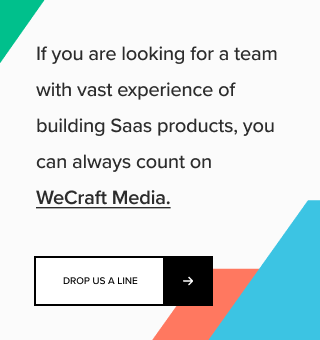Do you have a great idea for a SaaS product? Are you scratching your head with what to do with it and how to move forward with building that product? Well, you are in luck! Keep reading through the simple 7-step process you should follow in turning your idea into reality.
Lets start with defining what a SaaS product actually is. SaaS product, which stands for “Software as a service”, typically is a software you use over the internet, via browser or a dedicated app, built for this product. Usually you’d pay subscription to use the software, instead of buying it. One of the main advantages of the SaaS applications is convenience. it can be used anywhere in the world, as long as you have a good enough internet connection.
Coming up with the idea is one of the founding moments in building a SaaS product, but not the only one.
If you already have the idea, that’s fantastic. Now you are probably wondering what the best way is to proceed with building and selling it to customers.
As any seasoned entrepreneur or developer will tell you, the journey from concept to a successful SaaS product is a multilayered process that requires careful planning, execution, and iteration. As broad as the process can seem, it can all be summarized in 7 steps:
-
Validate your idea
-
Create a Business plan
-
Build an MVP (Minimum Viable Product)
-
Gather feedback
-
Improve
-
Scale
-
Continue improving …
Before we start, I’d like to mention that I’ll spend more time on the first 3 steps, as they are crucial for starting up a SaaS product. Once your product has an MVP and is used by actual customers, you’ll need to switch from “starting” to “improving & scaling”.
With that said, let’s get into it.
1. Validate Your Idea
Validating your idea is the best way to plan the process from the very beginning. The purpose of validation is to provide a solid justification for whether your assumptions about the problem and its solution are correct… or at least on the right track.
So far so good, but what exactly does it mean to validate an idea and how should you go about such task? To make things a bit clearer, we will review the basic steps for validating an idea:
Market Research. Market research is essential in helping you understand the demand for the product you are trying to build. This process helps to determine whether there is a viable market for your product, what needs it addresses, and how it should be positioned relative to competitors. Here are some practical points to follow in researching the market:
- Investigate the market to understand the demand for your product. Researching broader market trends that impact your product category. For example, a company creating wearable tech might study trends in health and technology to understand growing health concerns that their products could address.
- Identify your target audience and analyze their needs, preferences, and pain points. Your target audience is the customers you are trying to sell your product to. For example, a fitness app designed for busy professionals might use demographics, behaviours and interests through initial onboarding surveys, app usage patterns, social media integration and marketing analytics to focus on individuals who prioritize fitness but struggle with time management due to their busy schedules.
- Look at existing competitor solutions and determine how your product can offer a unique value proposition.
Competitor Analysis: Once you have recognized who your competitors are, you need to examine them:
- What their strengths and weaknesses are. You might want to research your competitor products, use them and even talk to their customers.
- What gaps your product fills that theirs cannot. And why! This will help you refine your idea and find your niche.
- Analyzing sales data from potential competitor products or services to predict potential market demand. This could include looking at online sales trends, retail distribution data, or performance metrics from comparable products.
Customer Feedback: No one knows better about the problem you are trying to solve than the customers you are trying to solve it for. Find and engage them as early as possible:
- Ideally, when you have an idea for a SaaS product, you’ve already encountered the problem in one of two ways: you’ve had the problem yourself or you know people who do and you can easily talk to them. Either way, to try solving this problem, you have to be an expert about it.
- Approaching your potential customers, you might want to research their behaviour and how they currently go about solving the problem
- One way to reach a larger group is by creating and distributing surveys to potential customers to gather data on their needs, preferences, and purchasing behaviour. For example, a company planning to launch a new fitness app might survey people about their exercise habits, preferences for virtual vs. in-person training, and willingness to pay for a subscription service.
- Use focus groups to gather feedback. This direct input can provide valuable insights and help you tailor your product to meet real needs. For example, a software company developing an educational tool for schools might organize focus groups with teachers and administrators to gauge their interest and gather feedback on specific features.
Once you have enough data to support your idea, and potential users have validated it, you will not only have more confidence marching forward, but you might also have the very first users for your product, waiting for you to build it. Don’t be afraid to talk about your idea, get people excited about it as much as you are.
After validating your idea, or even while you are doing it, you’ll need to start thinking about the business part of it and start developing the Business plan.
2. Create a Business Plan
To build a successful product you’ll need a solid business plan. Working on it, you’ll need to come up with the right answers to the following key points:
What is your Value Proposition: Your product’s value proposition should be a clear statement that outlines the unique benefits and value that your product delivers to its customers. It describes why a customer would choose your product over competitors’ offerings, highlighting specific advantages such as cost savings, improved efficiency, or enhanced capabilities. Effective value propositions are straightforward, easy to understand and compelling enough to capture the interest of the target audience.
What is your Target Market: To answer this question, try defining your ideal customer and market size. Which are the key parameters of the “ideal customer” and what is the scope of the market your product will be entering into.
- Is it a local market, regional, or global?
- is the product solving a very niche problem, with a handful of potential clients, or is it aimed at a larger pool of users?
- what is the potential for scalability? And how easy is to get to your potential customers?
What is the products’ Revenue Model: How will you monetize your product? A good starting point would be to research your competitor products revenue models. Another approach would be to research how much customers are willing to pay for your product.
- Common SaaS models include subscription-based pricing, freemium models, pay-per-use and other.
- You might also consider using advertising or affiliate programs.
Marketing and Sales Strategy: Although this might seem like a premature time to think about this problem, it’s crucial to define how you introduce your product to potential users. Try outlining how you will attract and retain customers.
- Consider digital marketing like creating ad campaigns, banners and posters at certain places, where you know your potential perfect customers would be.
- Content marketing in the form of blog posts could significantly increase the interest for your product.
- Social media presence, in any form, is basically mandatory nowadays – posting content frequently will boost brand awareness and will make your product recognisable.
- Don’t underestimate partnerships opportunities.
Financial Projections: Estimate your costs, revenues, and profitability over time. You should begin with the startup development and initial operation costs as the first big costs you’ll need to manage.
- Start with the costs for building the MVP (Minimum Viable Product). The MVP is a basic version of your product with just enough features to satisfy early users and gather feedback for future development. It’s tempting to build as much as possible right at the start, with the hope that this will win you customers. But that could also present a huge risk for your product. There is a reason it’s called Minimum Viable Product – you have to stick to the bare minimum to what exactly solves your potential customers’ problem.
- You might also want to consider the startup operational cost. Apart from the cost of building the MVP, you’ll encounter various other costs, such as salaries, rent, utilities, equipment, marketing, software subscriptions and legal or accounting services needed to maintain daily operations.
- You should also consider how, if needed, to get some outside funding for your startup. Many startups nowadays are bootstrapped, developed in-house or by small sub-contractor teams, which allows building products without the need of serious funding. But if you are considering outside funding, especially as early as on idea stage, you should start thinking about developing a compelling pitch deck, have a well-defined revenue model and prepare some strong financial projections.
3. Build a Minimum Viable Product (MVP)
If the first two steps can be considered planning, this is where you get your hands dirty and start building the product. The MVP should be a simplified version of your product that includes only the essential features. The goal is to launch quickly, attract early users, and gather feedback. Think of your product’s MVP as the first version of the software, not as the perfect product you see in your mind.
There usually is a big temptation to build as much as possible in the MVP, trying to consider every customer’s need or pain point you can think of. This is mainly under fear that coming short will hurt your product or user’s validation irreversibly. You should fight this fear! A scarier thought would be to be late and miss the opportunity.
The earlier you present something to your customers, the better.
In a high overview, the steps to building an MVP can be outlined in 3 simple points:
Prioritize Features: You should identify the core functionalities that address the primary problem and deliver value. This usually consists of couple or several features, which are right to the point and don’t bring a lot of whistles and bells to the party. Avoid feature creep at this stage. For example a restaurant ordering app will focus first on building functionality for the restaurants to upload their menu, users to make an order and pay for it and only after will proceed to features such as loyalty programs and integrating reviews & ratings.
Choose the Right Technology Stack: Select technologies that best suit your product’s requirements. For non-technical founders this might be a foggy place, where things loose meaning a bit. Luckily, you don’t have to tackle this question alone – you can look around for technical co-founders, gather a team to build the product or you can rely on a software development agency already specialized in this.
Develop and Test: Once you’ve come up with a plan on what you want to build and how you want to build it, it’s time to actually build the MVP and conduct thorough testing to ensure it works smoothly. This step is very dynamic and consists of many meetings and reviews. Once you’ve built the MVP as planned, it’s time for testing, addressing any bugs or usability issues, and eventually launching your product. It’s worth noting that the MVP development phase is a substantial endeavor, meriting its own detailed blog post. This phase encompasses numerous critical steps, including establishing requirements, wireframing, creating mockup designs, development, and integration, among others.
4. Launch and Gather Feedback
Once you get to this step, you can consider a big milestone has been reached. However, things are still just at the beginning. Focus on:
Beta Testing: It’s recommended to release your MVP to a small group of early adopters. Use their feedback to make improvements and validate your product assumptions. This can be a group of friends, potential clients or even a paid audience, hired specifically to test out your product.
Marketing Efforts: Utilize your marketing plan to generate buzz and attract users. Leverage social media, content marketing, and email campaigns to reach your target audience.
Analytics: Implement analytics tools like Google Analytics to track user behaviour, engagement, and other key metrics. This data will guide your next steps and help you understand user needs.
5. Iterate and Improve
With time every founder must realize that product development is an ongoing process. You should always be listening to your customers, use their feedback and data you’ve collected to refine and enhance your product:
Feature Enhancements: Remember all the features you wanted to build, but you had to drop off at the MVP stage? Well, now is the time you revise them. Ask your users if they need these features, follow their behaviour and how they use your product, to determine what other features they might need. Adding functionality, which is requested by your customers, will significantly increase your products’ value proposition.
Performance Optimization: Performance issues are inevitable, as is the ever changing technology stack. With time, as a founder, you must ensure your product runs smoothly and efficiently. Address any performance bottlenecks and scalability issues.
User Experience (UX) Improvements: Continuously refine the user interface and experience to make it more intuitive and enjoyable.
6. Scale Your Product
Once your product has gained traction and you’ve iterated based on feedback, focus on scaling:
Infrastructure: Ensure your technical infrastructure can handle growth. Consider cloud services like AWS that offer scalability and reliability.
Marketing and Sales Expansion: Scale your marketing and sales efforts to reach a broader audience. Explore new channels and strategies to drive growth.
Customer Support: As your user base grows, so will the demand for support. Invest in customer support teams and tools to maintain high satisfaction levels.
7. Measure and Optimize
Continuous improvement is necessary for every product. This last step is actually repeating steps 4 to 6 over and over again, for as long you want your product to exist.
Always improving is about continuously monitoring the key performance indicators (KPIs) to assess your product’s success and areas for improvement. For your product this might be metrics like:
- user acquisition
- retention rates
- customer satisfaction
- revenue growth
If at the beginning of your startup you are more inclined to trust your intuition and act on assumptions, at later stages every product should evolve to always use factual data and make informed decisions to optimize their strategies.
Final thoughts
Turning a SaaS idea into a successful product is a challenging yet rewarding journey. As every journey, it start with the first small step, and if you stick with it long enough, it unfolds into an epic adventure. And journeys are always easier with someone by your side, an experienced guide, who can help you through the steps you are not sure of.
At WeCraft Media, we try to be that guide and a friend and we give our best to make your business dreams and ideas come true. If you already have an idea, and you are looking for a partner to help you build it, don’t hesitate, schedule a call.
Thank you and hope you enjoyed this piece.




